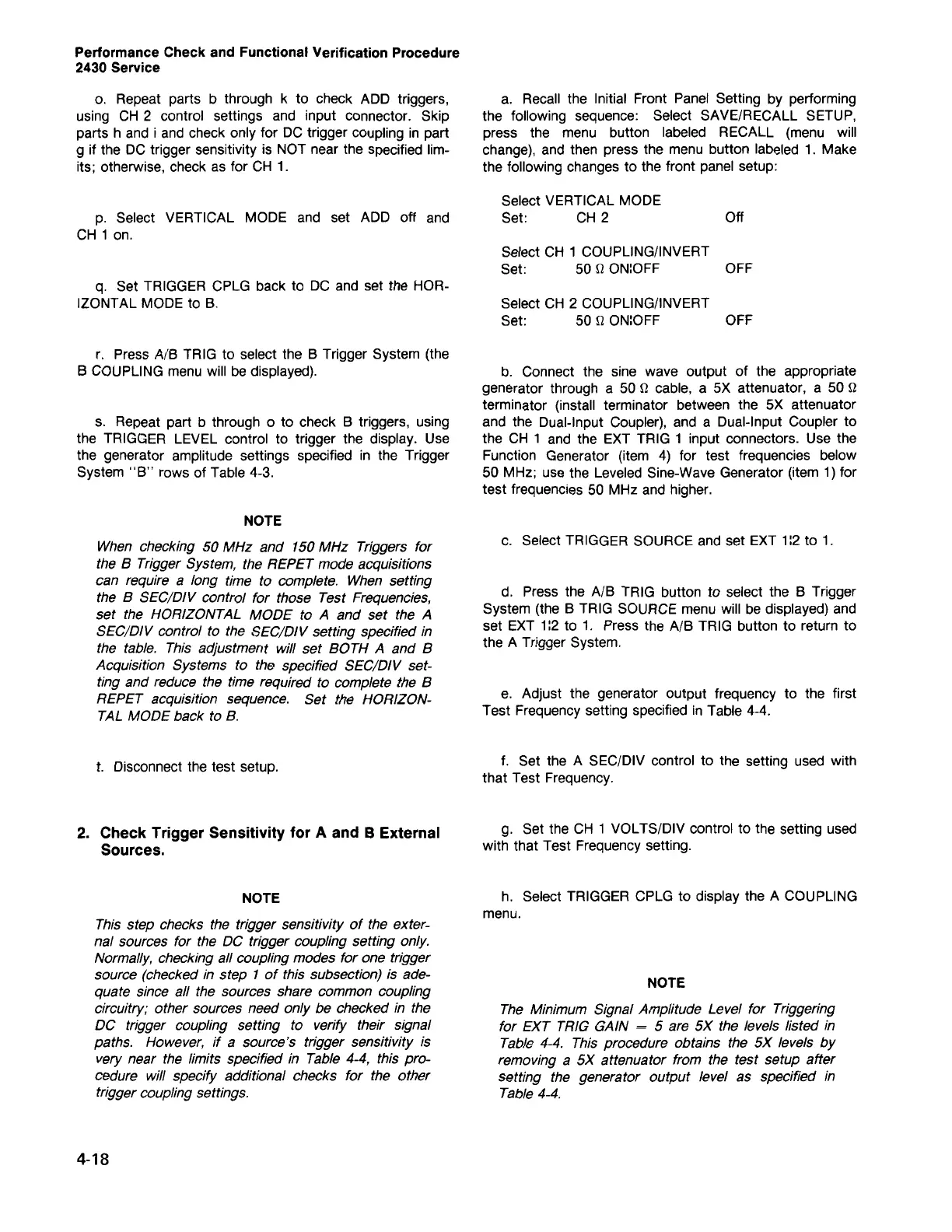The Minimum Signal Amplitude Level for Triggering
for EXT TRIG GAIN
=
5
are 5X the levels listed in
Table 4-4. This procedure obtains the 5X levels by
removing a 5X attenuator from the test setup after
setting the generator output level as specified in
Table 4-4.
NOTE
h. Select TRIGGER CPLG to display the A COUPLING
menu.
g. Set the CH 1 VOLTS/DIV control to the setting used
with that Test Frequency setting.
f. Set the A SEC/DIV control to the setting used with
that Test Frequency.
e. Adjust the generator output frequency to the first
Test Frequency setting specified in Table 4-4.
d. Press the A/B TRIG button to select the B Trigger
System (the B TRIG SOURCE menu will be displayed) and
set EXT 1:2 to 1. Press the A/B TRIG button to return to
the A Trigger System.
c. Select TRIGGER SOURCE and set EXT 1:2 to 1.
b. Connect the sine wave output of the appropriate
generator through a 50 Q cable, a 5X attenuator, a 50 Q
terminator (install terminator between the 5X attenuator
and the Dual-Input Coupler), and a Dual-Input Coupler to
the CH 1 and the EXT TRIG 1 input connectors. Use the
Function Generator (item 4) for test frequencies below
50 MHz; use the Leveled Sine-Wave Generator (item 1) for
test frequencies 50 MHz and higher.
Select CH 2 COUPLING/INVERT
Set: 50 Q ON:OFF OFF
Select CH 1 COUPLING/INVERT
Set: 50 Q ON:OFF OFF
Off
Select VERTICAL MODE
Set: CH 2
a. Recall the Initial Front Panel Setting by performing
the following sequence: Select SAVE/RECALL SETUP,
press the menu button labeled RECALL (menu will
change), and then press the menu button labeled
1.
Make
the following changes to the front panel setup:
4-18
This step checks the trigger sensitivity of the exter-
nal sources for the DC trigger coupling setting only.
Normally, checking all coupling modes for one trigger
source (checked in step 1 of this subsection)
is
ade-
quate since all the sources share common coupling
circuitry; other sources need only
be
checked in the
DC trigger coupling setting to verify their signal
paths. However, if a source's trigger sensitivity
is
very near the limits specified in Table 4-4, this pro-
cedure will specify additional checks for the other
trigger coupling settings.
NOTE
2. Check Trigger Sensitivity for A and B External
Sources.
t. Disconnect the test setup.
When checking 50 MHz and 150 MHz Triggers for
the B Trigger System, the REPET mode acquisitions
can require a long time to complete. When setting
the B SEC/DIV control for those Test Frequencies,
set the HORIZONTAL MODE to
A
and set the
A
SEC/DIV control to the SEC/DIV setting specified in
the table. This adjustment will set BOTH
A
and B
Acquisition Systems to the specified SEC/DIV set-
ting and reduce the time required to complete the B
REPET acquisition sequence. Set the HORIZON-
TAL MODE back to B.
NOTE
s. Repeat part b through
0
to check B triggers, using
the TRIGGER LEVEL control to trigger the display. Use
the generator amplitude settings specified in the Trigger
System "B" rows of Table 4-3.
r. Press A/B TRIG to select the B Trigger System (the
B COUPLING menu will be displayed).
q. Set TRIGGER CPLG back to DC and set the HOR-
IZONTAL MODE to B.
p. Select VERTICAL MODE and set ADD off and
CH
1
on.
o. Repeat parts b through k to check ADD triggers,
using CH 2 control settings and input connector. Skip
parts hand i and check only for DC trigger coupling in part
g if the DC trigger sensitivity is NOT near the specified lim-
its; otherwise, check as for CH 1.
Performance Check and Functional Verification Procedure
2430 Service
